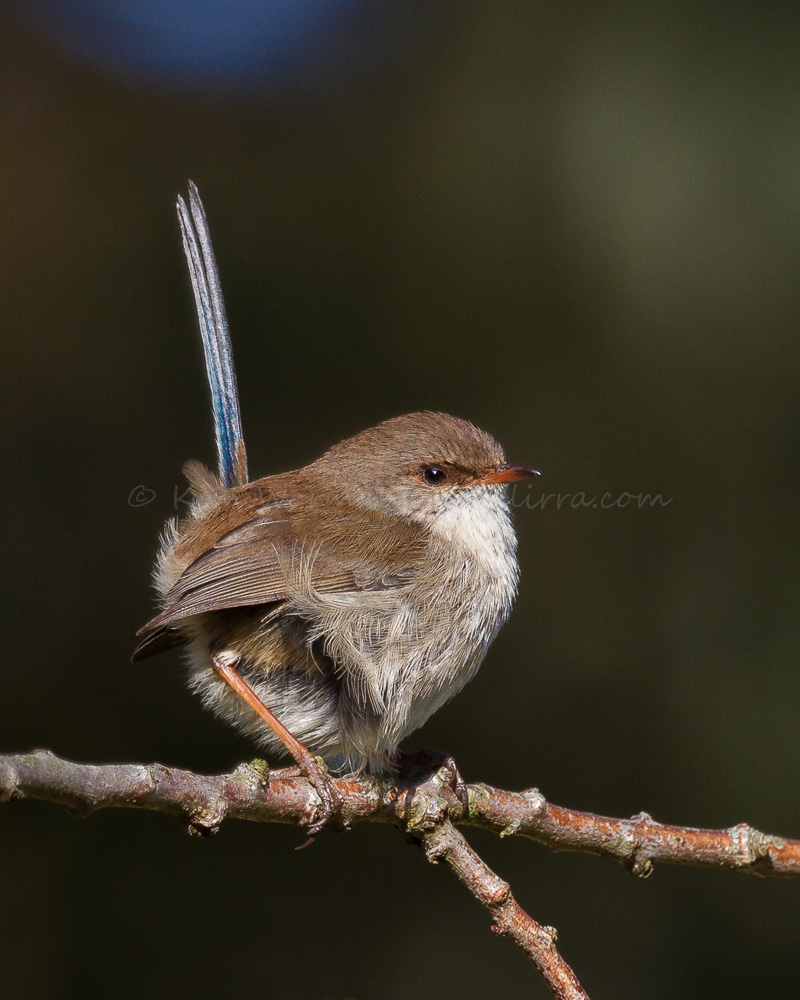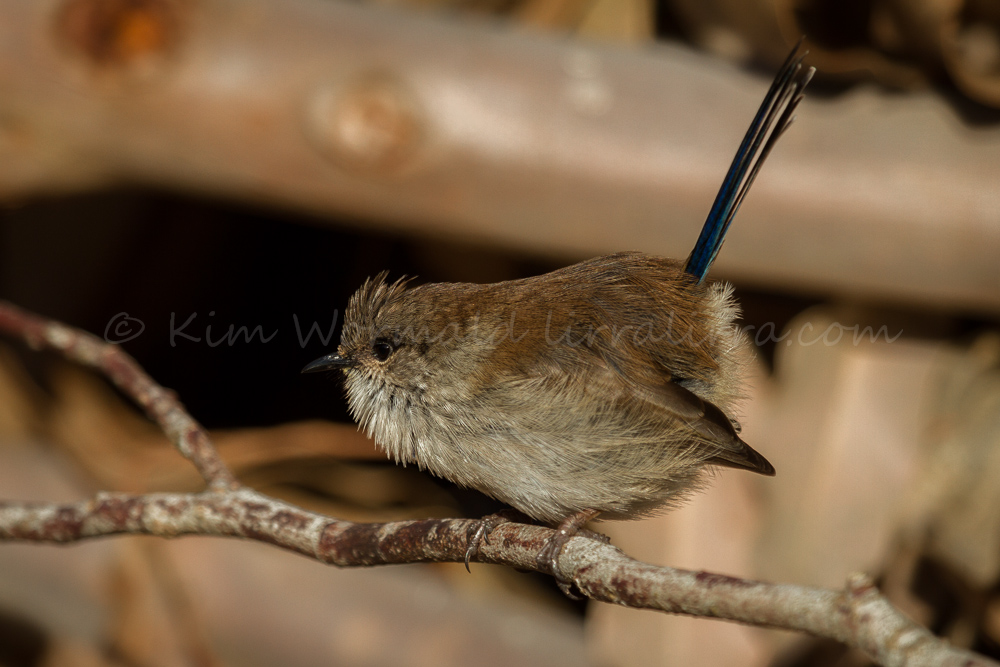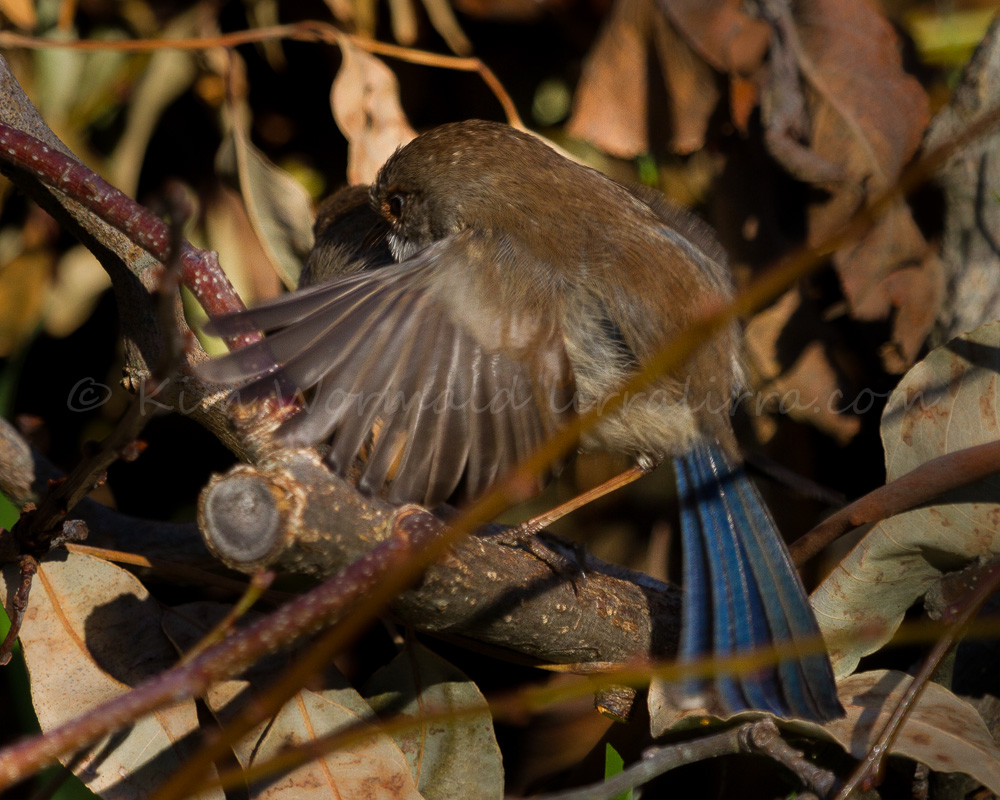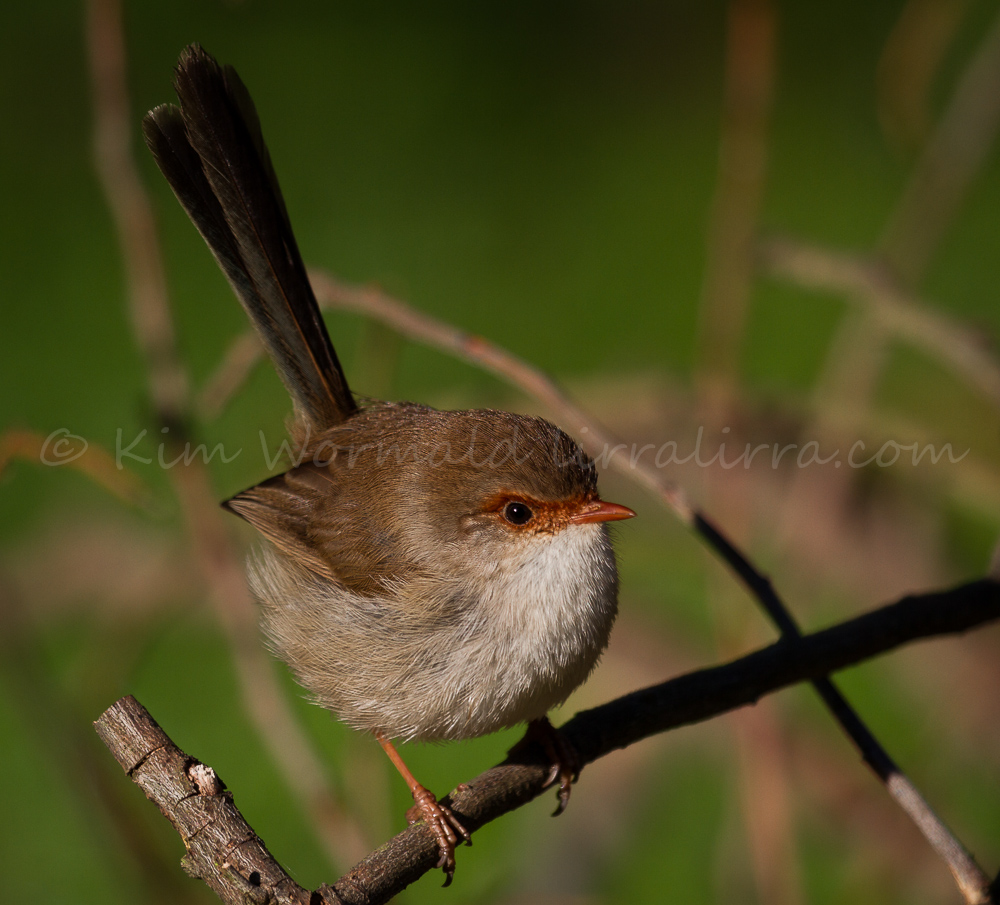Superb Fairy-wrens are beautiful birds and this week I’ve been watching and photographing them in the garden. They move rapidly, hopping and darting hither and thither (what a strange word) as they forage on open ground and in low shrubs for arthropods such as insects, grubs, caterpillars and spiders. I spent most time with a small group of three fairy-wrens; one female with two non-breeding males – well, that’s what they are supposed to be but clearly they haven’t read the same books I have.
 Superb Fairy-wren (Malurus cyaneus) – juvenile male number one
Superb Fairy-wren (Malurus cyaneus) – juvenile male number one
Canon 7D, 100-400mm L IS USM, 1/640, f/5.6, ISO 200, focal length 390mm
What a handsome boy! I can tell he is one of last year’s hatchlings from the colour of his feathers and bill; it’s exciting to see him as we lost at least one nest due to excessive heat. All juvenile Superb Fairy-wrens hatch with brown bills but males’ bills turn black during their first winter. The bird in the image above has a bill which is in the process of changing colour; the base is brown while the tip is black. Most of his plumage is typical of juveniles of either gender but his tail is becoming blue and looked exquisite in the early morning light. He will develop the bright blue feathers indicative of male Superb Fairy-wrens during his first breeding season: at the moment he is, according to the text books anyway, a non-breeding male.
 Superb Fairy-wren (Malurus cyaneus) – juvenile, or eclipse, male number two
Superb Fairy-wren (Malurus cyaneus) – juvenile, or eclipse, male number two
Canon 7D, 100-400mm L IS USM, 1/500, f/5.6, ISO 200, focal length 365mm
The image above shows the second non-breeding male. His bill is black, his tail is blue but the rest of his colouring is typical of female and juvenile Superb Fairy-wrens: brown above with lighter underparts. The strange pose in the image was his reaction to a odd sound in the undergrowth, it was funny to see him puff himself up to such a scary size.
 Superb Fairy-wren (Malurus cyaneus) – female
Superb Fairy-wren (Malurus cyaneus) – female
Canon 7D, 100-400mm L IS USM, 1/500, f/5.6, ISO 100, focal length 400mm
Along with the brown colouring above and lighter underparts female Superb Fairy-wrens have brown bills, brown eye-rings and brown lores; lores are the area between the bill and the eye. The female above was busy foraging along with the two juvenile males.
 Superb Fairy-wren (Malurus cyaneus) – juvenile male and female
Superb Fairy-wren (Malurus cyaneus) – juvenile male and female
Canon 7D, 100-400mm L IS USM, 1/640, f/5.6, ISO 320, focal length 350mm
As the female perched on a branch I pressed the shutter button and took a series of three images on continuous high-speed shooting. In the first image she is lifting her tail, in the second image the ‘non-breeding’ male mates with her and by the third image, two one-hundredths of a second later, it’s all over. I’m not positive which of the non-breeding males it is but it may be the juvenile as I can see brown colouring near his eye and his bill appears brownish when I enlarge the image in Lightroom.
 Superb Fairy-wren (Malurus cyaneus) – female
Superb Fairy-wren (Malurus cyaneus) – female
Canon 7D, 100-400mm L IS USM, 1/500, f/5.6, ISO 100, focal length 380mm
The female, above, seemed a bit dazed after the encounter but their promiscuity has been well-documented. Fairy-wrens have a fascinating social life which is not at all how it appears. The male that seems to rule the roost has rarely fathered the brood that he helps to raise. Female Superb Fairy-wrens sneak away during the night to visit neighbouring territories for a pre-dawn liaison with the dominant male. There is a breeding male in my garden at the moment with a larger group of fairy-wrens. His plumage is the bright blue and black typical of breeding males, which can be seen in several lirralirra posts including Wrens, raven and Gang-gang Cockatoos and Superb Fairy-wrens. I’m very interested in the behaviour I witnessed this week and am wondering if the three wrens have been expelled from the larger group, or if there is another explanation. If anyone has ideas I would be pleased to hear from you.
Superb Fairy-wrens build their nests at or near ground level and because of this their tiny broods are particularly vulnerable to predation by cats. Their numbers have declined in urban areas but I am hopeful that as the number of responsible cat owners increases the fairy-wrens may be able to re-establish themselves in some areas. Many cat owners now ensure that their cats are kept inside at all times or are confined in enclosures, some of which are elaborately designed with direct access from the house. These measures not only help decrease the estimated almost one million birds killed by cats each year but also reduce injuries to the cats themselves from fighting, foxes and traffic as well as decreasing the likelihood of them coming into contact with dangerous feline illnesses.
Hopefully in the coming weeks there will be fledgling fairy-wrens in my garden, and hopefully I’ll be able to get some images to share.
Happy birding, Kim
NB It is now possible to receive a weekly email letting you know that lirralirra has been updated – just add your address to the ‘Subscribe to email’ box above right.
Also, I recently added a Facebook ‘like’ button. Thank you to all ‘likers’ – I like you too!

[…] Females fairy-wrens sneak away for pre-dawn liaisons with males that visit their territories during the breeding season. It seems likely that the males who show up looking irresistibly handsome receive the most visits. For more about the social structure of fairy-wrens, the mating habits of non-breeding/juvenile males (captured on film), and how to tell a juvenile male from a female (apart from which one’s on top!), you could visit Fairies at the bottom of the garden […]
Late to the party – but delighted (as always) by your images. I have just sent the link to a friend who is revelling in a fairy wren on the cliffs at Bondi. Thank you – from us both.
Thank you EC, I’m so pleased that you and your friend enjoyed the images, thank you for sharing the link, happy birding.
hooo, it s a cute bird, and i apreciate a lot all the attitudes you have got,
the tail position is very fun and makes it very unusual
thanks kim, have a nice WE ☺
Hi Eric, they are fun little birds, you’re right! I’m glad you like them. You have a good weekend too 🙂
v interesting kim. great shots
Thank you Glenn!
These are such fun images and so well done! I love the information on this bird and they sound like a lot of fun to watch!
They are heaps of fun to watch Sherry, I’m glad you enjoyed the images and information 🙂
These are wonderful Kim and the behavior you describe is fascinating! How terrific it must be to have these beauties in your yard.
I couldn’t believe the luck of actually getting the image! I’ve got other images of friendly wrens but seeing a non-breeding male clearly breeding has made me wonder if there is any research that talks about males ‘tricking’ other males by remaining in eclipse plumage. Hopefully someone will let me know, or maybe I’ll forward it to an ornithologist … ah, good idea!
Hello Kim
Oh my god, he’s so cute !!!!!
What book have you read ? Lol…. His tail is very very beautiful ! In France they are a little different, but still the tail in the air.
Thank’s Kim, yours photos are superb !
Kiss
Well it wasn’t a best seller Nathalie, haha, but very interesting non-the-less! If the wrens in France are like the ones in the UK they are gorgeous, I’ve always liked wrens. Thank you for your kind comments.
Superb images Kimberley, no pun intended!
LOL Mary and thank you!
The are adorable birds! Wonderful photos and a great post! Have a happy weekend!
Thank you Eileen, you have a happy weekend too!
I’m glad I know my cat has never killed any of these gorgeous little peeps. Very interesting!
An inside cat is a happy cat! Thanks for commenting 🙂